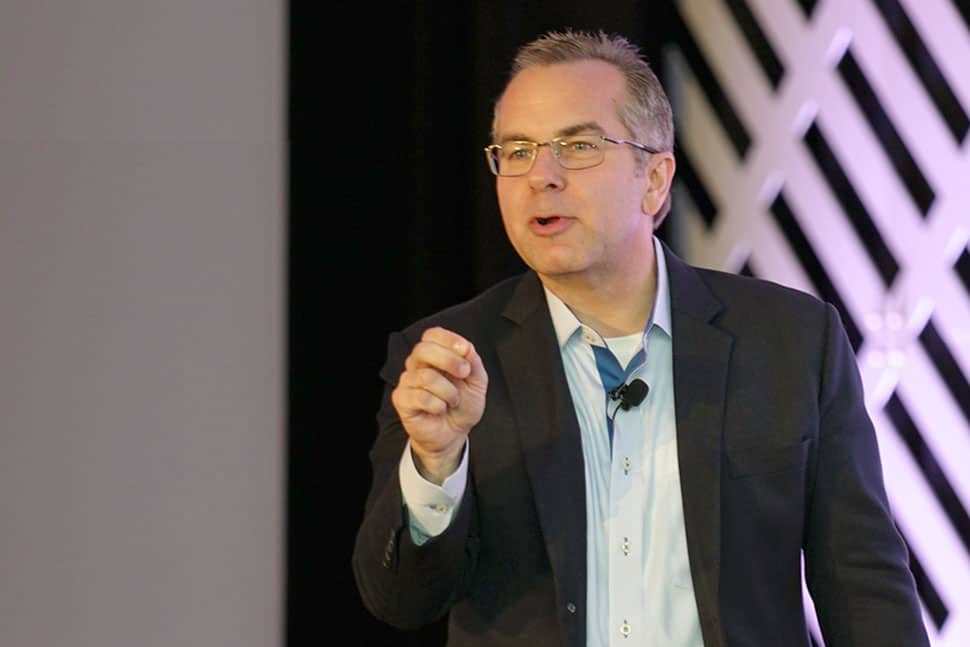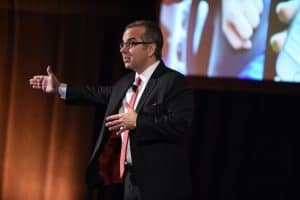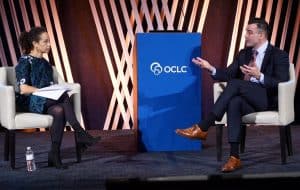
OCLC’s Americas Regional Council 2019 Library Futures Conference rallied an energetic audience October 2–3 in Phoenix to discuss libraries’ future leadership in changing communities. The conference theme was “Community Catalysts.”
On October 2, OCLC President and CEO Skip Prichard opened the day by outlining the five Cs that libraries need to catalyze their communities. Libraries contribute, developing unique offerings that help make them indispensable. Through those contributions, they forge connections. Catalysts create, introducing big changes and little shifts. They compete, constantly pushing themselves forward. And they ultimately choose, from all the goals that they can pursue, the ones most important to their communities. The greatest catalysts maintain a positive view of the future, Prichard said.
Featured speaker Pam Sandlian Smith, director of Anythink Libraries in Adams County, Colorado, and past president of the Public Library Association, brought the five Cs to life in her presentation on leading the transformation of the struggling Rangeview Library District—which once comprised the worst-funded libraries in Colorado—into the Anythink brand. Sandlian Smith said she focused on “opening doors for curious minds.” She and her team form connections by keeping “space for people” as a mantra, she said. But 10 years into the Anythink vision, the team is challenging itself again: “We don’t have it all figured out yet. Because of our values, a supportive community, and an optimistic attitude, we can invent and become anything.”
Collaborative partnerships
“Healthy Communities, Impactful Libraries” featured librarians from the National Network of Libraries of Medicine (NNLM) Southeastern/Atlantic region. April Wright, community engagement coordinator for the All of Us Research Program, discussed the important role of public and academic libraries in promoting health information. In Tennessee, Memphis Public Library and University of Tennessee Health Science Center partnered to create community health information centers in three branches, hosting health fairs, community discussions, and movie screenings. Nashville Public Library (NPL) and Vanderbilt University worked together to expand the library’s “Be Well at NPL” program, which includes movement-based programs, nutrition classes, and mindfulness and stress management workshops. Outreach, Education, and Communications Coordinator Liz Waltman explained how library professionals could participate in #CiteNLM Wikipedia edit-a-thons, events that help improve the already popular online resource with citations to trusted National Library of Medicine resources such as PubMed, MedlinePlus, and Genetics Home Reference.

In the session “Innovating through Collaborative Partnerships,” Debra Riley-Huff, director of the Design and the Arts Library at Arizona State University (ASU), offered insight into a library that is transforming to keep pace with a rapidly changing academic community. Led by ASU President Michael Crowe, the school is pursuing a vision for what it calls a New American University, “a comprehensive knowledge enterprise dedicated to the simultaneous pursuit of excellence, broad access to quality education, and meaningful societal impact,” according to its website. That vision has led to new transdisciplinary departments and academic units, such as a School for the Future of Innovation in Society and a Center for Science and the Imagination. Riley-Huff highlighted the library’s deep engagement across campuses, which has resulted in new attempts to embed collections in online courses and a new makerspace focused on biomimicry—just two examples from a library that is transforming to serve 72,000 students across five campuses and another 30,000 online.
The changing composition and characteristics of library staff was the focus of “Developing Staff Talent and Future Leaders.” Jolie O. Graybill, assistant director of Minitex (a resource-sharing program at University of Minnesota) and a recent recipient of a PhD from Simmons University’s Managerial Leadership in the Information Professions program, shared her research on generational perceptions of leadership. While generations already in the workforce adhere to many shared perceptions of leadership, younger generations, including millennials, are showing growing concern for the ways leaders promote life/work balance (“life” intentionally the leading half of that balance). Tony Zanders, entrepreneur-in-residence at Boston University (BU) Libraries, discussed the distinctions that organizations are trying to make between “talent” and “human resources.” While HR concerns itself with the compliance and legal issues required to bring in new staff, “talent” considers the processes and systems related to recruiting, retaining, and developing a team to drive the organization forward. The shift has led BU Libraries staff to develop a culture of constant recruitment, one in which messages of positive opportunities in their organization are shared well before a position is even advertised.
The landscape of tribal libraries
Featured speaker Alyce Sadongei, project coordinator for the American Indian Language Development Institute (AILDI) at University of Arizona, closed the day by sharing an important and poignant message about the role and work of tribal libraries in Arizona and across the US. Honoring the indigenous communities of Arizona, Sadongei helped attendees recognize landscape as a central carrier of traditional and cultural memory, providing a sense of where Native people have been and where they are now. Since the 1970s, and with the guidance of organizations and programs like the American Indian Library Association; the Association of Tribal Archives, Libraries, and Museums; and the Smithsonian Institution’s American Indian Museum Studies Program, tribal communities have developed libraries, archives, museums, and cultural centers to document and interpret tribal cultures as they define them.
John Szabo, city librarian at Los Angeles Public Library and OCLC board chair, noted during his OCLC board update that events like the Library Futures Conference serve as a reminder that small and large libraries can learn from each other. Similarly, attendees noted the power and potential for public, academic, school, and special libraries to think about their futures together.
OCLC’s Library Futures Conference continues with the Asia Pacific Regional Council meeting in Singapore, November 20–21, and the Europe, Middle East, and Africa Regional Council in Vienna, Austria, March 3–4, 2020.


